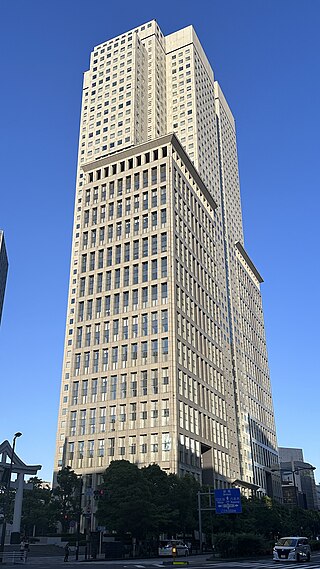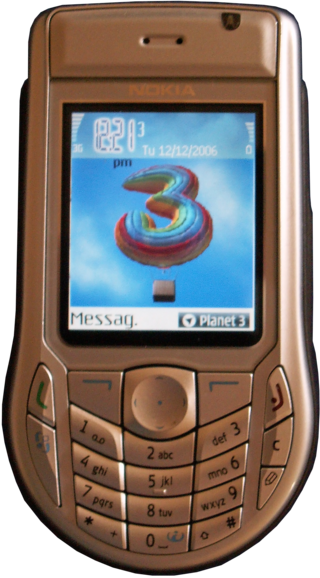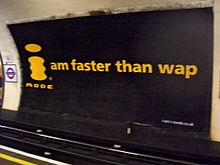The Universal Mobile Telecommunications System (UMTS) is a 3G mobile cellular system for networks based on the GSM standard. Developed and maintained by the 3GPP, UMTS is a component of the International Telecommunication Union IMT-2000 standard set and compares with the CDMA2000 standard set for networks based on the competing cdmaOne technology. UMTS uses wideband code-division multiple access (W-CDMA) radio access technology to offer greater spectral efficiency and bandwidth to mobile network operators.
A SIM lock, simlock, network lock, carrier lock or (master) subsidy lock is a technical restriction built into GSM and CDMA mobile phones by mobile phone manufacturers for use by service providers to restrict the use of these phones to specific countries and/or networks. This is in contrast to a phone that does not impose any SIM restrictions.
DoJa profile is a Java application environment specification for DoCoMo's i-mode mobile phone.

NTT Docomo, Inc., also known as Docomo, is a Japanese mobile phone operator owned by the Nippon Telegraph and Telephone (NTT). The name is officially an abbreviation of the phrase, "do communications over the mobile network", and is also from a compound word dokomo, meaning "everywhere" in Japanese. The company is headquartered in Sanno Park Tower, Nagatachō, Chiyoda, Tokyo. Docomo provides phone, video phone, i-mode (internet), and mail services. It is the largest wireless carrier in Japan, with 82.632 million subscribers as of March 2021.

Freedom of Mobile Multimedia Access (FOMA) is the brand name of the W-CDMA-based 3G telecommunications services being offered by the Japanese telecommunications service provider NTT DoCoMo. It is an implementation of the Universal Mobile Telecommunications System (UMTS) and was the world's first 3G mobile data service to commence commercial operations.

In Japan, mobile phones became ubiquitous years before the phenomenon spread worldwide. In Japanese, mobile phones are called keitai denwa (携帯電話), literally "portable telephones," and are often known simply as keitai (携帯).

Vodafone live! was the brand name for the multimedia portal service of mobile phone operator Vodafone, offering news content, picture messaging, instant messaging, email, and downloadable ringtones and games. The service officially launched on 24 October 2002, originally in eight countries. The first compatible phones were the Japanese Sharp GX10 and Panasonic GD87, and the Nokia 7650.
Sha-Mail was a 2G mailing and picture messaging service launched by J-Phone in 2000 that allowed users to take a photo with their mobile phone and send it to another user on the service as an email attachment. A related service introduced in 2002, Video Sha-Mail, let users record and send videos as well. Sha-Mail was widely successful upon its launch, became a household name in Japan, and sparked a boom in camera phone services worldwide. The term derives from sha, the first part of the Japanese word shashin, and mail.

The Nokia 6630 is a 3G mobile phone announced by Nokia on 14 June 2004 and released in November. It runs on Symbian OS 8.0a. Codenamed Charlie during development, it is an evolution of the 6600 and 6620 smartphones, supporting tri-band GSM.

Wi-Fi calling, also called VoWiFi, refers to mobile phone voice calls and data that are made over IP networks using Wi-Fi, instead of the cell towers provided by cellular networks. Using this feature, compatible handsets are able to route regular cellular calls through a wireless LAN (Wi-Fi) network with broadband Internet, while seamlessly change connections between the two where necessary. This feature makes use of the Generic Access Network (GAN) protocol, also known as Unlicensed Mobile Access (UMA).

The HTC TyTN is an Internet-enabled Windows Mobile Pocket PC PDA designed and marketed by High Tech Computer Corporation of Taiwan. It has a touchscreen with a left-side slide-out QWERTY keyboard. The TyTN's functions include those of a camera phone and a portable media player in addition to text messaging and multimedia messaging. It also offers Internet services such as e-mail, instant messaging, web browsing, and local Wi-Fi connectivity. It is a quad-band GSM phone with GPRS, and EDGE, and a single/dual band UMTS phone with HSDPA. It is a part of the first line of PDAs directly marketed and sold by HTC. On AT&T/Cingular, the TyTN was the successor to the HTC Wizard, known as the Cingular 8125. Also on AT&T, the TyTN was superseded by the HTC TyTN II, known as the AT&T 8925 and the AT&T Tilt.

Wireless Application Protocol (WAP) is a now obsolete technical standard for accessing information over a mobile cellular network. Introduced in 1999, WAP allowed at launch users with compatible mobile devices to browse content such as news, weather and sports scores provided by mobile network operators, specially designed for the limited capabilities of a mobile device. The Japanese i-mode system offered another major competing wireless data standard.

The Tizen Association, formerly the LiMo Foundation, is a non-profit consortium which develops and maintains the Tizen mobile operating system. Tizen is a Linux-based operating system for smartphones and other mobile devices. The founding members were Motorola, NEC, NTT DoCoMo, Panasonic Mobile Communications, Samsung Electronics, and Vodafone. The consortium's work resulted in the LiMo Platform—which was integrated into mobile phone products from NEC, Panasonic and Samsung—and later became the Tizen platform.
MOAP is the software platform for NTT DoCoMo's Freedom of Mobile Multimedia Access (FOMA) service for mobile phones.

The Symbian Foundation was a non-profit organisation that stewarded the Symbian operating system for mobile phones which previously had been owned and licensed by Symbian Ltd. Symbian Foundation never directly developed the platform, but evangelised, co-ordinated and ensured compatibility. It also provided key services to its members and the community such as collecting, building and distributing Symbian source code. During its time it competed against the Open Handset Alliance and the LiMo Foundation.
In telecommunications, long-term evolution (LTE) is a standard for wireless broadband communication for mobile devices and data terminals, based on the GSM/EDGE and UMTS/HSPA standards. It improves on those standards' capacity and speed by using a different radio interface and core network improvements. LTE is the upgrade path for carriers with both GSM/UMTS networks and CDMA2000 networks. Because LTE frequencies and bands differ from country to country, only multi-band phones can use LTE in all countries where it is supported.
Novarra was a mobile internet software company founded in 2000 and based in Itasca, Illinois, United States. It created web-based services such as web internet access, portals, videos, widgets and advertising for mobile devices. Novarra provided access to the internet and other services through wireless handsets, PDAs and laptops and sold directly to operators, mobile handset manufacturers and internet brand companies. In 2010, Nokia acquired 100% of Novarra's shares.

The Japanese mobile phone industry is one of the most advanced in the world. As of March, 2022 there were 199.99 million mobile contracts in Japan according to the Ministry of Internal Affairs and Communications. This is 158 percent of Japan's total population.

ACCESS CO., LTD., founded in April 1979 and incorporated in February 1984 in Tokyo, Japan, by Arakawa Toru and Kamada Tomihisa, is a company providing a variety of software for connected and mobile devices, such as mobile phones, PDAs, video game consoles and set top boxes.
Enhanced Voice Services (EVS) is a superwideband speech audio coding standard that was developed for VoLTE and VoNR. It offers up to 20 kHz audio bandwidth and has high robustness to delay jitter and packet losses due to its channel aware coding and improved packet loss concealment. It has been developed in 3GPP and is described in 3GPP TS 26.441. The application areas of EVS consist of improved telephony and teleconferencing, audiovisual conferencing services, and streaming audio. Source code of both decoder and encoder in ANSI C is available as 3GPP TS 26.442 and is being updated regularly. Samsung uses the term HD+ when doing a call using EVS.













